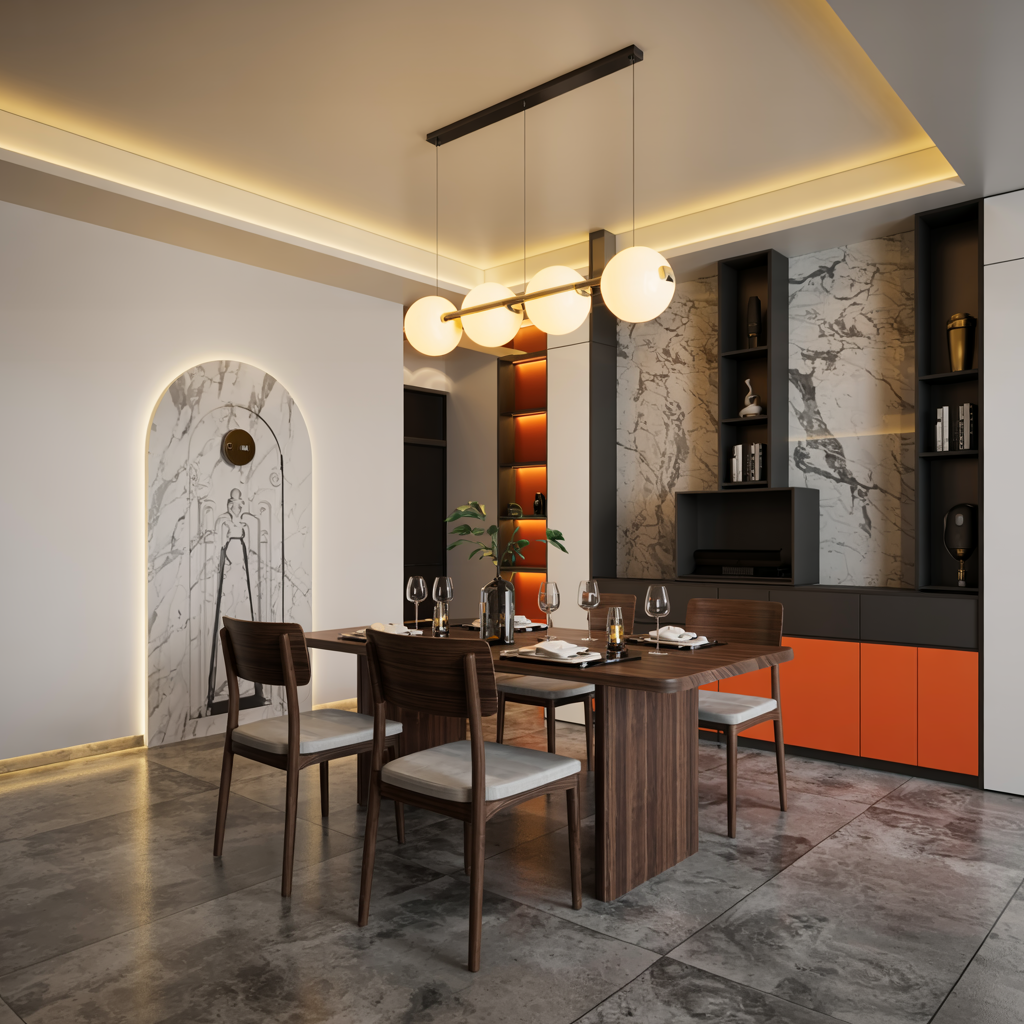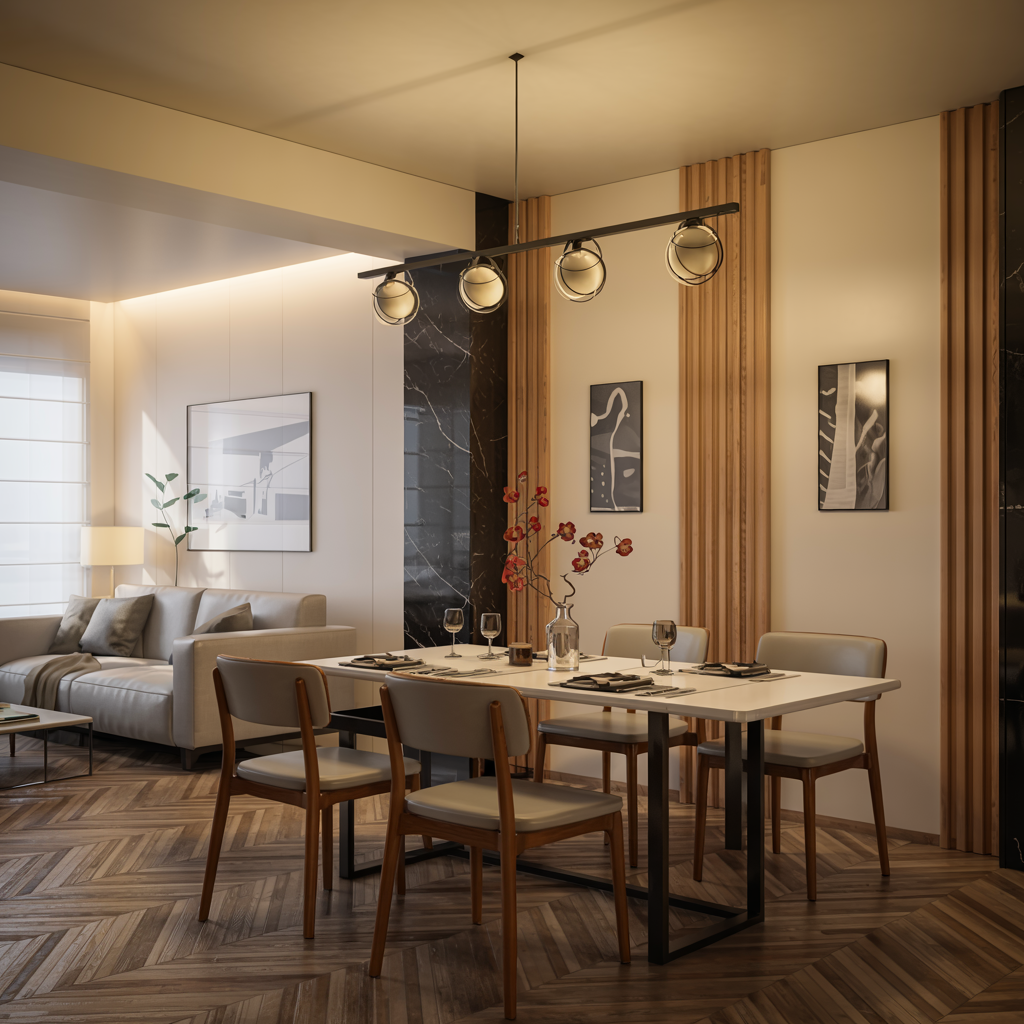How Low Should a Dining Room Light Hang?: The Ultimate Guide
Creating the perfect ambiance in your dining room involves many elements, but one often overlooked detail is the height of your dining room light fixture. How low should a dining room light hang? This comprehensive guide will explore the ideal hanging height for various dining room light styles, ensuring both functionality and aesthetic appeal. You’ll…
Creating the perfect ambiance in your dining room involves many elements, but one often overlooked detail is the height of your dining room light fixture. How low should a dining room light hang? This comprehensive guide will explore the ideal hanging height for various dining room light styles, ensuring both functionality and aesthetic appeal. You’ll learn to calculate the perfect height based on your table size, ceiling height, and the type of fixture you’ve chosen. We’ll cover different lighting styles and their optimal hanging heights, helping you create a stunning and inviting dining space.
The height of your dining room light fixture significantly impacts the overall atmosphere and functionality of your space. A light that hangs too low can be a safety hazard and obstruct conversation, while one that hangs too high can leave your
dining table in shadow.
How Low Should a Dining Room Light Hang?
A dining room light should hang 30 to 36 inches above the table surface. This height ensures proper illumination while keeping the fixture out of direct sight lines. For rooms with ceilings higher than 8 feet, raise the fixture by about 3 inches for each additional foot of ceiling height.
Measuring Your Dining Room for Optimal Lighting Height

Before determining the ideal hanging height, measure the height of your ceiling and the diameter of your dining table. These measurements are crucial for accurate calculations. Consider also the overall style of your room and the style of your fixture. A modern minimalist pendant might hang differently than a large ornate chandelier.
Follow these simple steps to find the perfect height for your dining room light:
1. Measure Table to Ceiling Height
- Use a tape measure to determine the distance from the floor to the ceiling.
- Most ceilings are 8 feet high. If yours is taller, make note of the exact height.
2. Set Standard Hanging Height
- For an 8-foot ceiling, hang the light 30 to 36 inches above the table.
- For each extra foot of ceiling height, add 3 inches to the hanging height.
Example: 9-foot ceiling = 33 to 39 inches above the table.
3. Measure Table Dimensions
- Measure the length and width of your dining table.
- The light fixture should be about one-half to two-thirds the table’s width for proper balance.
4. Check Eye Level and Glare
- Sit at the table to check if the fixture blocks your view or causes glare.
- Adjust height slightly for comfort and aesthetics.
5. Center the Fixture
- Ensure the light hangs centered over the table, not necessarily the room.
- Use a level to double-check alignment.
Read More: Where Should Call Lights be Placed in Residents Rooms?
Standard Hanging Heights for Dining Room Lights

A general rule of thumb is to hang your light fixture 30-36 inches above your dining table. However, this is a starting point, and adjustments may be needed based on your specific setup and the type of fixture. Consider the fixture’s size; larger fixtures require more clearance.
Calculating the Ideal Hanging Height Based on Ceiling Height
Higher ceilings allow for more flexibility in hanging height. For ceilings over 9 feet, you can hang your light fixture a bit lower than the standard range, perhaps 30 inches above the table. For lower ceilings, you may need to adjust upward slightly.
| Ceiling Height | Recommended Hanging Height (Above Table) |
|---|---|
| 8 feet | 30 – 36 inches |
| 9 feet | 33 – 39 inches |
| 10 feet | 36 – 42 inches |
| 11 feet | 39 – 45 inches |
| 12 feet | 42 – 48 inches |
Types of Dining Room Light Fixtures and Their Ideal Hanging Heights
Different types of fixtures have different hanging height considerations. Chandeliers often require more vertical space than pendants or flush mounts. Consider the fixture’s size and shape when determining the optimal height. A large, elaborate chandelier might need to hang higher than a sleek, modern pendant.
Hanging Heights for Different Table Sizes
A larger dining table requires a light fixture that provides adequate illumination across its entire surface. In such cases, a slightly higher hanging height may be necessary to prevent shadows and ensure even distribution of light.
The Role of Ambient Lighting in Dining Room Design
Dining room lighting is more than just a single overhead fixture. Ambient lighting, provided by recessed lights or wall sconces, complements the main fixture, creating a layered and inviting atmosphere. Careful consideration of these elements ensures a properly lit space.
Choosing the Right Light Fixture for Your Dining Room
The selection of your light fixture itself plays a significant role. Its size, style, and design all impact the overall aesthetic and functionality of the room. Consider the overall design scheme of the space before making a selection.
Factors Affecting Ideal Hanging Height: Style and Design
The style of your dining room and the overall design aesthetic heavily influence the appropriate hanging height. A modern, minimalist space might suit a pendant light hung slightly higher, while a traditional room might prefer a chandelier hanging lower.
Safety Considerations When Hanging a Dining Room Light
Safety is paramount. Ensure that the fixture is securely mounted and that the hanging height allows for safe passage and avoids accidental head bumps. It’s crucial to follow all manufacturer’s instructions and, if needed, consult with a qualified electrician.
Maintaining Your Dining Room Light Fixture
Regular maintenance is essential for the longevity and performance of your lighting fixture. Cleaning, replacing bulbs, and checking for loose wires are crucial tasks to maintain its optimal functionality and safety.
Common Mistakes to Avoid When Hanging a Dining Room Light
Avoid hanging the light too low, which can be hazardous, or too high, leaving the table in shadow. Avoid fixtures that are too small or too large for the space. Accurate measurements and planning are key to success.
Comparing Different Hanging Heights: Practical Examples
Let’s look at examples. A 36-inch diameter table under an 8-foot ceiling would benefit from a light hung around 32-34 inches above the table. A larger table with a higher ceiling allows for more flexibility in hanging height.
Read More: Slanted Ceiling Lighting Ideas: Bright Solutions for Unique Angles
Troubleshooting Issues with Dining Room Light Height
If your light fixture creates harsh shadows or doesn’t adequately illuminate your dining table, readjust the hanging height or consider adding additional lighting sources, such as wall sconces or table lamps.
Using Dimmers to Control Lighting Levels
Dimmers offer flexibility in controlling the brightness of your dining room lighting. This allows you to adjust the ambiance to suit the occasion, from a bright, airy setting for daytime gatherings to a warm, intimate glow for evening dinners.
Integrating Technology into Your Dining Room Lighting
Smart lighting systems allow for remote control and customizable lighting scenes. This technology allows for precise control and the ability to create different atmospheres for various occasions and moods.
Creating a Cohesive Lighting Scheme for Your Dining Room
Ensure a cohesive lighting scheme by combining ambient, task, and accent lighting. This layered approach creates a dynamic and well-lit dining space. Task lighting, for instance, can be incorporated with strategically placed table lamps.
The Impact of Light Color Temperature on Dining Ambiance
The color temperature of your light bulbs significantly affects the atmosphere of your dining room. Warmer light temperatures (2700-3000K) create a cozy ambiance, while cooler temperatures (5000-6500K) offer a brighter, more energizing feel.
Frequently Asked Questions
What is the most common mistake people make when hanging a dining room light?
The most common mistake is hanging the light too low, creating a safety hazard and potentially obstructing conversation. Conversely, hanging it too high can leave the table inadequately lit. Careful measurement and planning are vital.
Can I use multiple light sources in my dining room?
Absolutely! Combining an overhead fixture with wall sconces or table lamps creates a layered lighting scheme, providing ambient, task, and accent lighting for a more balanced and inviting atmosphere. This offers flexibility and caters to various moods and activities.
What if my ceilings are very high or very low?
High ceilings offer more flexibility in hanging height, allowing you to potentially hang the fixture lower. For lower ceilings, you might need to hang the fixture higher to avoid it feeling overwhelming or cramped. The goal is to maintain visual balance and comfort.
How do I choose the right size light fixture for my dining table?
The diameter of your dining table is a key factor. A general rule is to choose a fixture whose diameter is at least one-third to one-half the diameter of your table. However, always consider the overall scale of the room to avoid a fixture that feels too large or too small.
What type of bulbs are best for dining room lighting?
LED bulbs are an excellent choice, offering energy efficiency, longer lifespan, and various color temperature options to suit your preferences. Consider warm white (2700-3000K) for a cozy atmosphere or cooler white (5000-6500K) for a brighter setting.
How often should I clean my dining room light fixture?
The frequency depends on the type of fixture and how dusty your home is. Generally, cleaning every few months is recommended to maintain its appearance and ensure optimal light output. Dust buildup can reduce light intensity and potentially create a fire hazard.
Final Thoughts
Determining the optimal hanging height for your dining room light fixture is crucial for creating a functional and aesthetically pleasing space. By following the guidelines outlined above, you can ensure your light fixture enhances your dining room’s ambiance without compromising safety or convenience. Remember to measure your space carefully, consider the type and size of your fixture, and choose a hanging height that provides adequate illumination while maintaining a comfortable and stylish atmosphere. Don’t forget the power of layered lighting – combine your overhead fixture with other sources to create the perfect dining experience.
Start planning your perfect dining room lighting today! You’ll be amazed by the transformation a well-placed light fixture can bring.

